See details
READ MORE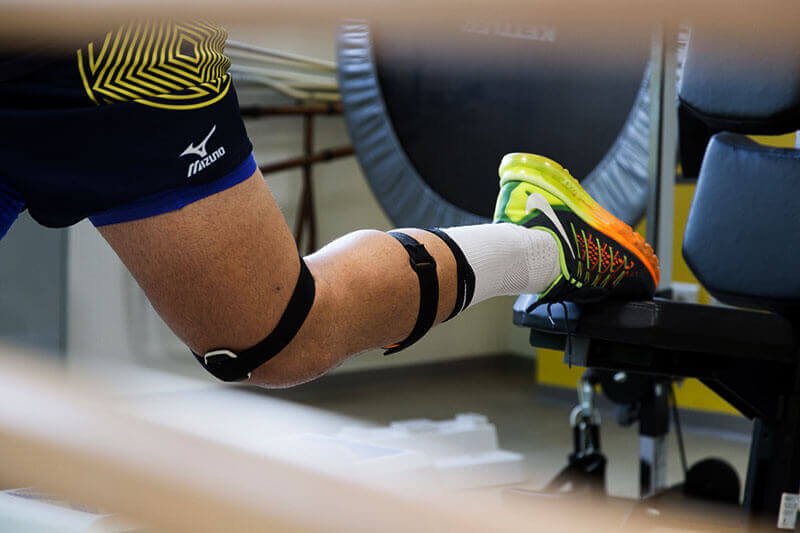
Recovery protocol after patellar tendon debridement
Phase 1 - weeks 0-2 postoperatively
Objectives:
- Protecting the cartilaginous implant
- Favoring healing
- Obtaining and maintaining a complete extension
- Obtaining a 90-degree flexion
- Fighting local edema
- Strengthening the quadriceps muscle
- Avoidance of thrombus formation in the pelvic limbs
Activities
- Orthosis/crutches: Use the knee orthosis when getting out of bed and walking. The orthosis will be set to maximum extension. You can put weight on the operated leg, but with the knee immobilized in the orthosis. You can use the crutches for extra stability when walking. Do not try to climb/descend stairs.
- Apply ice to reduce pain and swelling. Use ice according to the following schedule: 20 minutes ice, 20 minutes without during the first postoperative day. Then apply ice as many times as you feel the need for 15-20 minutes over the next postoperative days. Put a towel between the skin and the ice to prevent frostbite.
- You can take a shower and wet the surgical incision. However, do not soak it in the tub or Jacuzzi until the wires have been removed.
- Take an aspirin every morning.
- You can wear elastic stockings under the knees to prevent swelling of the feet. Also, do at least 10 ankle mobility exercises to prevent edema and prevent thrombophlebitis.
Exercise program:
Exercises of the quadriceps muscle - to maintain muscle tone at the thigh and to strengthen the knee.Sit on your back with your knee at maximum extension as shown. Contract and maintain the contraction of the anterior muscles of the thigh (quadriceps), the knee becoming flattened and straight. If done correctly, the patella will slide proximal to the thigh muscles.
.jpg)
Quadriceps muscle exercises - to maintain muscle tone in the thigh and to strengthen the knee. Sit on your back with your knee at maximum extension as shown. Contract and maintain the contraction of the anterior muscles of the thigh (quadriceps), the knee becoming flattened and straight. If done correctly, the patella will slide proximal to the thigh muscles.
Hold the contraction for 5 seconds. Perform at least 20 repetitions 3 or 4 times a day until you can stretch your knee to the same level as the unoperated part.
Heel slides - to regain your knee flexion. While lying on your back (figure), slide your heel to bend your knee. Continue to bend the knee until you feel a "stretch" in the anterior region of the knee. Hold the flexion for 5 seconds and then relieve the flexion and stretch the knee. While the knee is stretched, you can combine the exercises and repeat the quadriceps. Continue these exercises until you can bend the knee like the part without ACL injury (unoperated side). Also, as you regain your flexion, you can use a towel to progress with knee flexion. Repeat 20 times, 3 times a day.
Hip Abduction. Lie on your healthy side. The knees will be in maximum extension. Raise the operated up to 45 degrees, as in the figure below. Hold this position for a second, then return gently. Repeat 20 times.
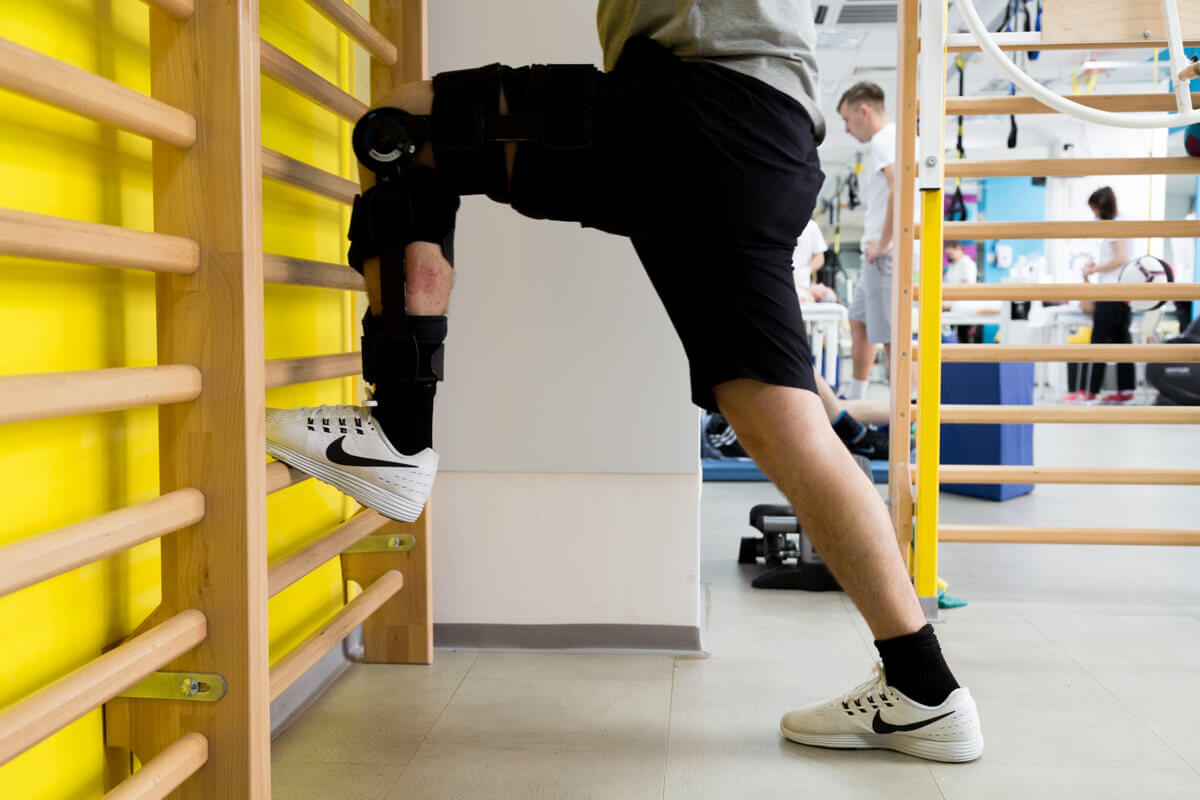
Phase 2: 2 to 6 weeks
Objectives:
- Normal walk
- Regaining complete mobility
- Regaining muscle strength
Activities:
- You can give up the orthosis while walking if you feel safe.
- Load completely on the operated leg. Avoid limping walk normally. Do not fully load on the foot when climbing/descending stairs.
- Continue with local ice applications.
Exercises program:
Medical bicycleUse a medical bicycle to mobilize the knee and increase its flexion. If you cannot perform a complete cycle, keep the operated foot on the pedal and pedal back and forth until the knee bends enough to allow a complete cycle. Most people manage a complete cycle first in the opposite direction, followed by the forward direction. You can use the bicycle, without resistance, for 10 to 20 minutes a day. Adjust the height of the bicycle saddle so that when you are riding the bike, the knee is fully extended when the pedal is in the lowest position. Pedaling will be done with the help of the forefoot (toe), and not the heel.
Quadriceps muscle exercises - to maintain muscle tone in the thigh and to strengthen the knee. Sit on your back with your knee at maximum extension as shown. Contract and maintain the contraction of the anterior muscles of the thigh (quadriceps), the knee becoming flattened and straight. If done correctly, the patella will slide proximal to the thigh muscles. Hold the contraction for 5 seconds. Perform at least 20 repetitions 3 or 4 times a day.

Heel slides to regain your knee flexion
While lying on your back (figure), slide your heel to bend your knee. Continue to bend the knee until you feel a "stretch" in the anterior region of the knee. Hold the flexion for 5 seconds and then relieve the flexion and stretch the knee. While the knee is stretched, you can combine the exercises and repeat the quadriceps. Continue these exercises until you can bend the knee like the part without ACL injury (unoperated side). Also, as you regain your flexion, you can use a towel to progress with knee flexion. Repeat 20 times, 3 times a day.
Extended Knee Lifts
In these exercises, it is primarily the contraction of the muscle that matters, not the ability to lift the leg.
- Contract the quadriceps when you can.
- Contract the muscle even harder!
- Raise your heel to 10-15 cm.
- Contract the quadriceps again.
- Lower your leg and heel back to the floor. Keep your quadriceps muscle as tense as you can.
- Contract the muscle again.
- Relax and repeat.
Short lifts
With your knee bent over a rolled towel or blanket, lift your leg so that your knee is fully extended. Keep your knee locked in extension for 5 seconds, then lower gently. Repeat 20 times.
Hip Abduction
Lie on your healthy side. The knees will be in maximum extension. Raise the operated up to 45 degrees, as in the figure below. Hold this position for a second, then return gently. Repeat 20 times.
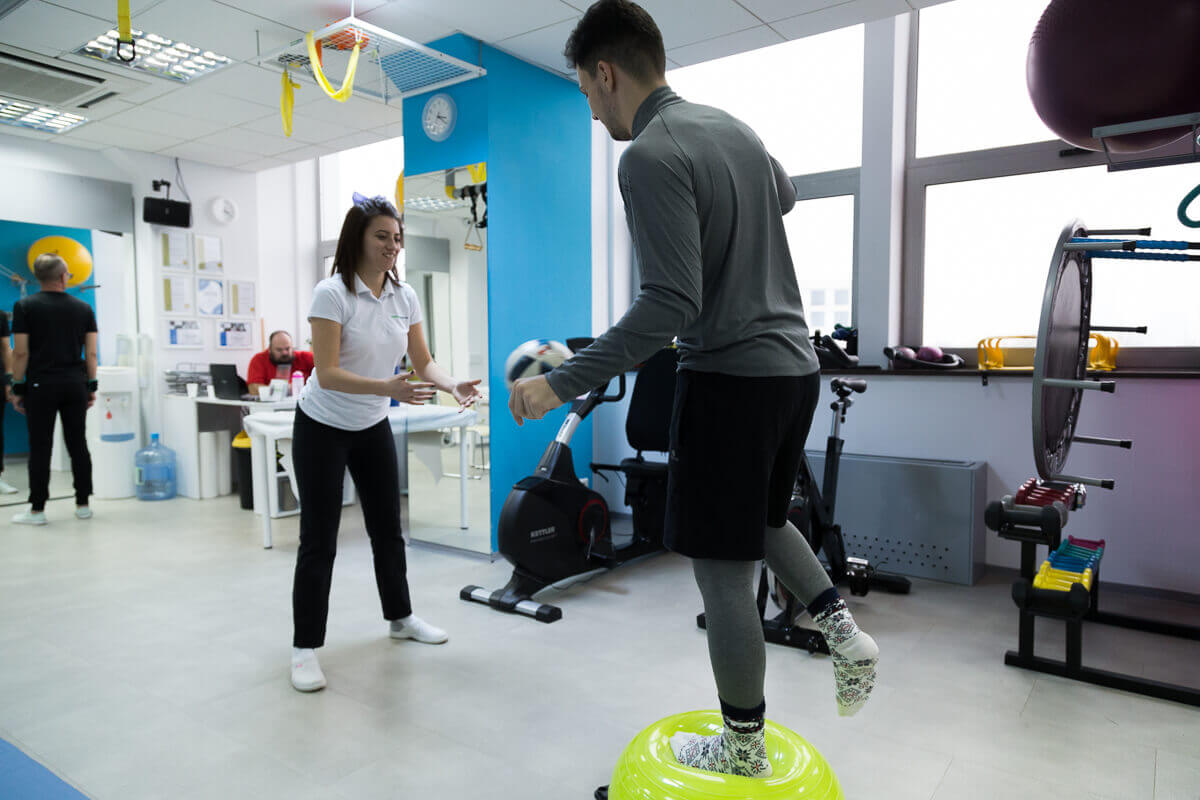
Stand up straight with your back and bottom touching the wall. Place your feet 30 cm away from each other and 6 cm away from the wall. Bend your knee and slide along the wall until your knees are bent at 45 degrees. Hold this position for 5 seconds and then return to the starting position. Perform 3 sets of 10-15 repetitions.
Phase 3: 6 to 12 weeks postoperatively
Squatting in the chair
In these exercises, lower your bottom toward the chair until you are seated. Do not rest in a chair, instead, get up immediately and return slightly to the starting position. Remember to keep your head above your feet and bend your pelvis as you descend. After the first week, you can hold dumbbells while performing these exercises. Start with 1.5 - 2.5 kg in each hand. You can add 1-2 kg per week until you reach 10 kg. Perform 3 sets of 10-15 repetitions each.
Step-up exercises
For this exercise, place a small stool, a book, or a piece of wood on the floor, about 60 cm from a wall. Place your injured foot on the stool. Maintain your balance by leaning on the wall. Gently lift on the stool and allow the knee to stretch slightly. Gently lower your opposite foot on the floor, trying not to rest, instead, immediately returning to the "stepped up" position. Start this exercise with 5 repetitions of 3 sets in the first week. Put add one repetition to each session, until you reach 15 repetitions if you do not feel pain in the knee or at the place of insertion of the patellar tendon.
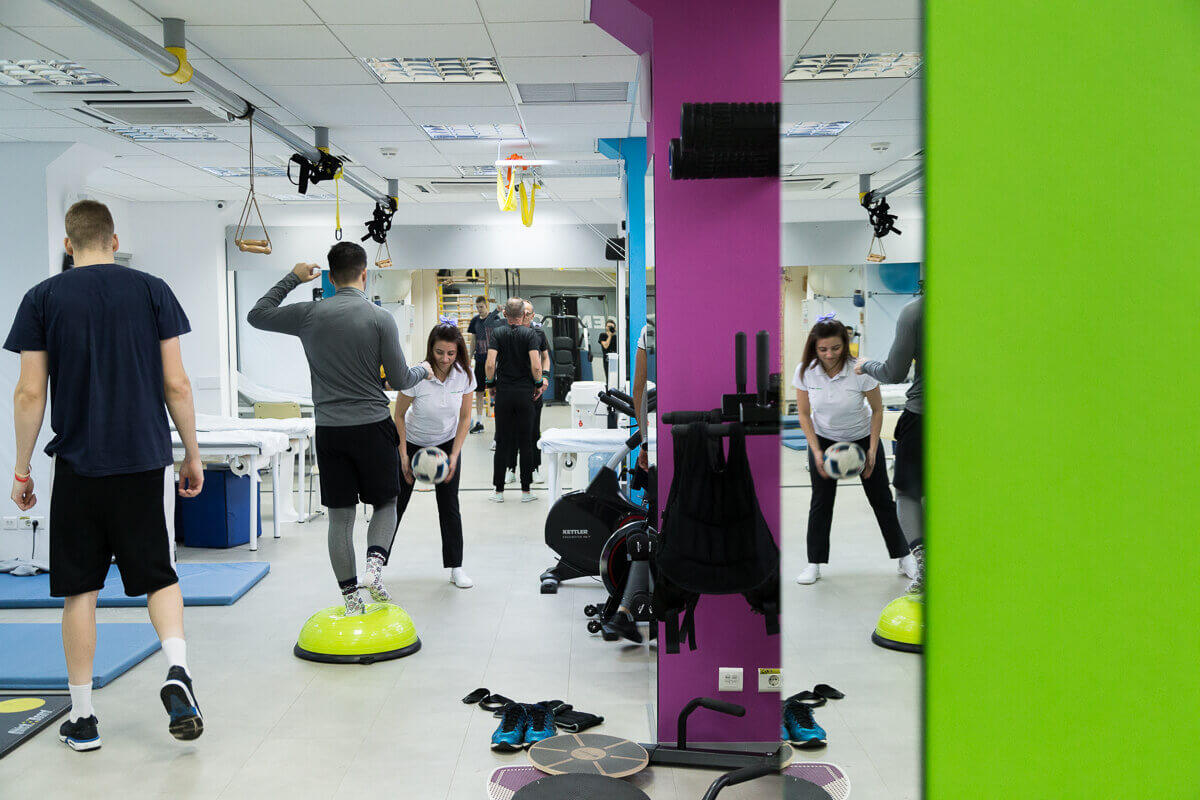
Stretching the quadriceps
This exercise is performed as in the adjacent position. Perform a movement near the heel. When you feel a stretch in the front of the thigh and knee, hold the position for 15-20 seconds for 3-5 repetitions.
Leg stretch
In the position shown, keep the heel straight on the floor, with the knee fully extended. Lean forward to the thighs, your hands supporting your weight. When you feel a slight stretch in the back of the leg and knee, hold this position for 15-20 seconds for 3-5 repetitions.
Additional exercises
The following exercises can be added to your schedule starting with 8 weeks post-injury:Foot press. For the starting weight, use an amount that you feel light enough to perform 20 reps. Use this weight for a week, then you can gradually increase it. The weight will be increased by 2.25 kg every 7-10 days, as long as you can perform 20 repetitions for 3 sets.
In this exercise, avoid allowing your knees to snap or extend rapidly as you reach the full stretch position. Avoid starting exercises with excessively flexed knees. Do not bend your knees so much that your leg and hip come into contact.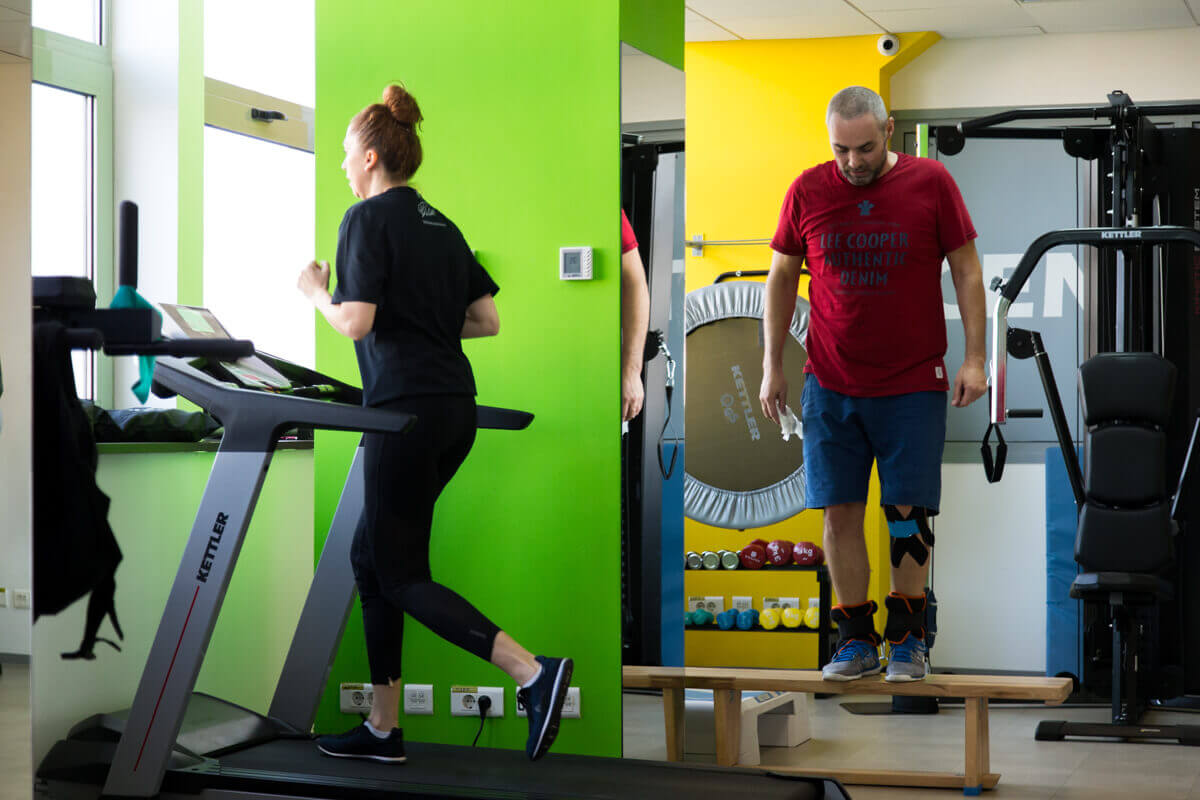

MAKE AN APPOINTMENT
CONTACT US
SUCCESSFUL RECOVERY STORIES
MAKE AN APPOINTMENT
FOR AN EXAMINATION
See here how you can make an appointment and the location of our clinics.
MAKE AN APPOINTMENT




































































































































